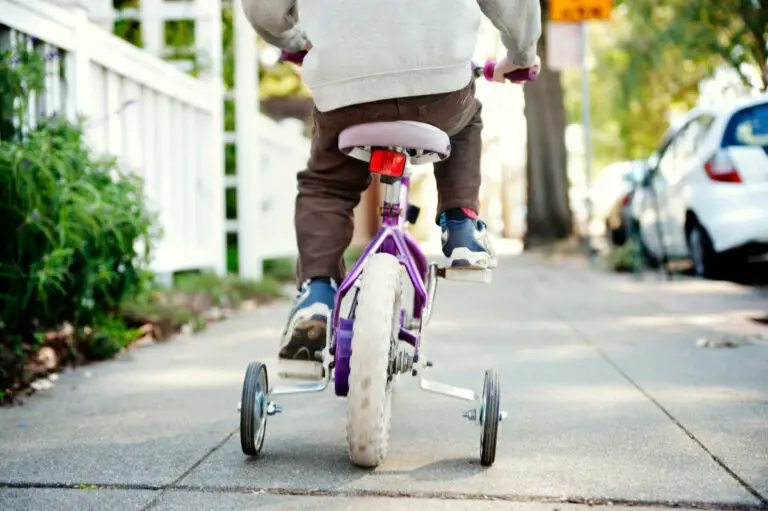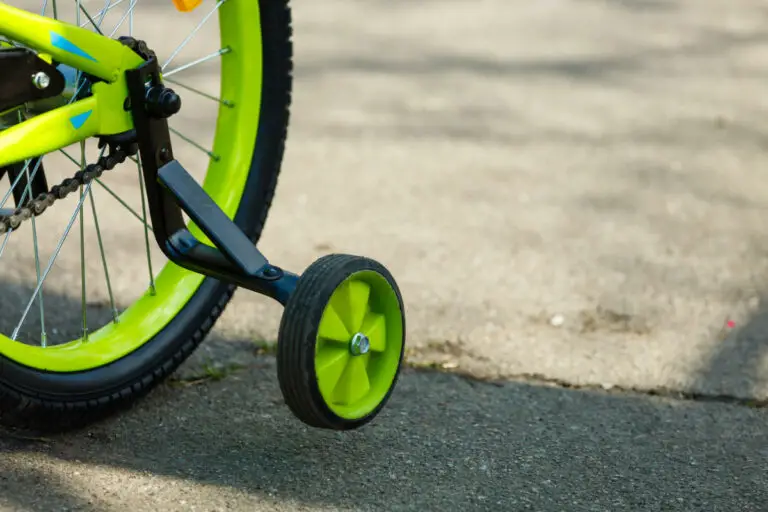When To Take Off Training Wheels?

Training wheels, also known as stabilizers, are a great tool for helping young children learn how to ride a bike.
They provide extra stability and balance, allowing kids to focus on pedaling and steering without worrying about falling over.
However, eventually, your child will need to learn how to ride a bike without training wheels.
In this article, we’ll go over when and how to take off training wheels, including what to consider when deciding if your child is ready, how to prepare for the transition, and how to teach your child to ride without training wheels.

Is Your Child Ready to Take Off Training Wheels?
Before beginning the process of removing training wheels, it is essential to determine whether your child is ready. Here are a few considerations:
- Age: Typically, children learn to ride a bicycle between the ages of 3 and 8. The age at which a child is ready to remove training wheels depends on his or her specific growth and ability level.
- Balance: Balance is one of the most important abilities youngsters must master in order to ride a bicycle without training wheels. If your child can ride a bicycle without holding onto anything, he or she may be ready to remove the training wheels.
- Confidence: Your child’s confidence is a further significant issue to consider. If they are afraid or anxious about riding without training wheels, it may be advisable to wait until they feel more confident.
- Physical coordination: Finally, your youngster must have excellent physical coordination to ride a bicycle without training wheels. This includes the ability to pedal, steer, and control the bicycle with hands and feet.
Preparing for the Transition
After determining that your child is ready to remove the training wheels, you can take a few steps to prepare for the transition. Here are a few tips:
- Practice balance: Start by removing one of the training wheels from the bicycle to assist your child to become comfortable with balancing. This will allow your toddler to practice balancing independently while maintaining equilibrium.
- Use a balance bike: A balance bike is a bicycle without pedals that children can use to learn to balance and steer. This might be an excellent tool for helping your youngster adjust to riding a bike without training wheels.
- Use a “glider” attachment: An alternative is to use a “glider” attachment, which enables your youngster to ride the bicycle with their feet off the ground. This can help kids develop a sense of balance and prepare them for the move to pedals.

Taking Off the Training Wheels
When both you and your child feel prepared, it is time to remove the training wheels!:
- Remove one of the training wheels: Remove one of the training wheels from the bicycle first. This will provide stability while your child learns to balance independently.
- Have your child practice balancing: Once the training wheel has been removed, have your youngster practice balancing by sitting on the bike. Encourage them to push off with their feet and glide across the ground.
- Add the pedals: Once your youngster has mastered balancing on the bike, it is time to attach the pedals. Attach the pedals to the bicycle and instruct your child to try pedaling while maintaining balance.
- Remove the other training wheel: Once your child is comfortable pedaling and maintaining balance on the bicycle, it is appropriate to remove the other training wheel. Remove the training wheels off the bicycle and have your child practice balancing and pedaling.
- Practice, practice, practice: The secret to learning how to ride a bicycle without training wheels is practice, practice, and more practice. Encourage your youngster to continue practicing on their bike until they feel comfortable and confident.
Teaching Your Child to Ride without Training Wheels
Now that the training wheels have been removed from your child’s bicycle, it is time to begin teaching them how to ride without them. Here are some suggestions to assist your youngster in learning to bike without training wheels:
- Start slow: Start by having your child pedal around slowly and deliberately. This will allow them to become accustomed to the sensation of the bike and pedals.
- Practice steering: Once your youngster is comfortable with pedaling, you should begin teaching them how to steer. Have them practice twisting the handlebars to the left and right to acquire a feel for how the bicycle reacts.
- Encourage balance: While the training wheels gave greater stability and balance, it is essential that your child learn how to balance on his or her own. Encourage them to practice maintaining their balance without holding onto anything, and gradually increase their riding pace.
- Use a helmet: When learning to ride a bike without training wheels, it is very crucial to always wear a helmet. Ensure that your child is wearing a helmet that fits properly to protect them in the event of a fall.
The removal of training wheels is a key milestone in your child’s development as a skillful cyclist.
You can help your child learn to ride without training wheels with confidence and ease by considering his or her preparedness, preparing for the transition, and practicing often.
They’ll be great riders in no time with a little patience and practice!






